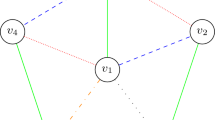Abstract
The optical wavelength-based machine, or simply w-machine, is a computational model designed based on physical properties of light. The machine deals with sets of binary numbers, and performs computation using four defined basic operations. The sets are implemented as light rays and wavelengths are considered as binary numbers. Basic operations are then implemented using simple optical devices.
In this paper, we have provided a polynomial lower bound on the complexity of any w-machine computing all satisfiable SAT formulas. We have shown that the provided lower bound is tight by providing such a w-machine. Although the size complexity of the SAT problem on w-machine is polynomial, but, according to the provided optical implementation, it requires exponential amount of energy to be computed.
We have also provided an exponential lower bound on the complexity of most of w-machine languages, by showing that when n tends to infinity, the ratio of n-bit languages requiring exponential size w-machine to be computed, to the number of all n-bit languages, converges to 1.
Access this chapter
Tax calculation will be finalised at checkout
Purchases are for personal use only
Preview
Unable to display preview. Download preview PDF.
Similar content being viewed by others
References
Meinders, E.R., Mijiritskii, A.V., van Pieterson, L., Wuttig, M.: Optical Data Storage: Phase-change media and recording, 1st edn. Springer (2006)
Maier, M.: Optical Switching Networks, 1st edn. Cambridge University Press (2008)
Gupta, S.: Optoelectronic Devices and Systems, vol. 1. Prentice-Hall of India Pvt. Ltd. (2005)
Dolev, S., Fitoussi, H.: Masking traveling beams:optical solutions for np-complete problems, trading space for time. Theor. Comput. Sci. 411, 837–853 (2010)
Goliaei, S., Jalili, S.: An optical solution to the 3-sat problem using wavelength based selectors. J. Supercomput. (in press)
Goliaei, S., Jalili, S.: Optical Graph 3-Colorability. In: Dolev, S., Oltean, M. (eds.) OSC 2010. LNCS, vol. 6748, pp. 16–22. Springer, Heidelberg (2011)
Goliaei, S., Jalili, S.: An Optical Wavelength-Based Solution to the 3-SAT Problem. In: Dolev, S., Oltean, M. (eds.) OSC 2009. LNCS, vol. 5882, pp. 77–85. Springer, Heidelberg (2009)
Oltean, M., Muntean, O.: An Optical Solution for the SAT Problem. In: Dolev, S., Oltean, M. (eds.) OSC 2010. LNCS, vol. 6748, pp. 53–62. Springer, Heidelberg (2011)
Haist, T., Osten, W.: An optical solution for the traveling salesman problem. Optics Express 15(16), 10473–10482 (2007)
Woods, D., Gibson, J.: Lower bounds on the computational power of an optical model of computation. Nat. Comput. 7(1), 95–108 (2008)
Woods, D., Naughton, T.J.: An optical model of computation. Theor. Comput. Sci. 334(1-3), 227–258 (2005)
Černý, V.: Quantum computers and intractable (NP-complete) computing problems. Phys. Rev. A 48(1), 116–119 (1993)
Greenwood, G.W.: Finding solutions to np problems: Philosophical differences between quantum and evolutionary search. In: Proc. 2001 Congress Evolutionary Computation, Seoul, Korea, pp. 815–822 (2001)
Shannon, C.: The synthesis of two-terminal switching circuits. Bell Sys. Tech. J. 28(1), 59–98 (1949)
Muller, D.E.: Complexity in electronic switching circuits. IRE Trans. Electron. Comput. EC-5(1), 15–19 (1956)
Author information
Authors and Affiliations
Editor information
Editors and Affiliations
Rights and permissions
Copyright information
© 2012 Springer-Verlag Berlin Heidelberg
About this paper
Cite this paper
Goliaei, S., Foroughmand-Araabi, MH. (2012). Lower Bounds on the Complexity of the Wavelength-Based Machine. In: Durand-Lose, J., Jonoska, N. (eds) Unconventional Computation and Natural Computation. UCNC 2012. Lecture Notes in Computer Science, vol 7445. Springer, Berlin, Heidelberg. https://doi.org/10.1007/978-3-642-32894-7_10
Download citation
DOI: https://doi.org/10.1007/978-3-642-32894-7_10
Publisher Name: Springer, Berlin, Heidelberg
Print ISBN: 978-3-642-32893-0
Online ISBN: 978-3-642-32894-7
eBook Packages: Computer ScienceComputer Science (R0)




